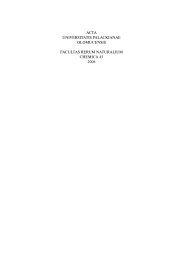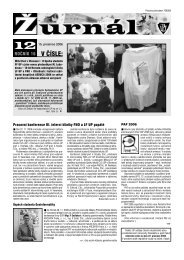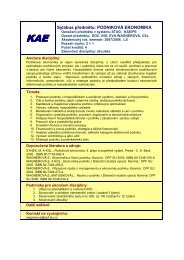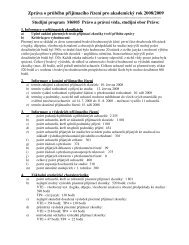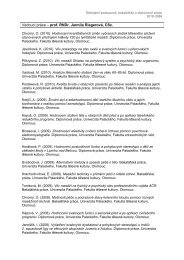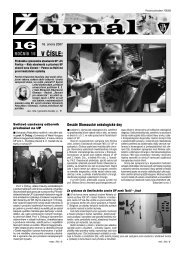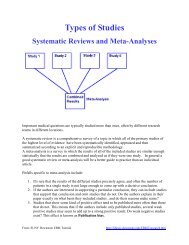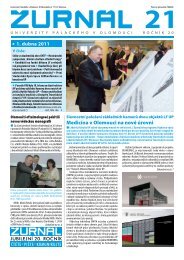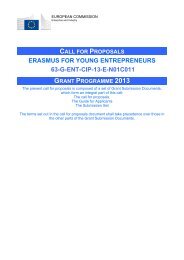ACTA UNIVERSITATIS PALACKIANAE OLOMUCENSIS GYMNICA ...
ACTA UNIVERSITATIS PALACKIANAE OLOMUCENSIS GYMNICA ...
ACTA UNIVERSITATIS PALACKIANAE OLOMUCENSIS GYMNICA ...
- No tags were found...
You also want an ePaper? Increase the reach of your titles
YUMPU automatically turns print PDFs into web optimized ePapers that Google loves.
Acta Univ. Palacki. Olomuc., Gymn. 2004, vol. 34, no. 2 47cycles/min. it is possible within this frequency rangeto exactly identify the frequency bound to respiration,which we regard as parasympathetic respiratorybound activity. Depending on the frequency ofrespiration, frequency shifts of this component occurup to the range assessed as the frequency range ofLF. Apart from parasympathetic respiratory boundactivity, we found in this frequency zone other subdominantfrequencies whose origin remains unclear.These subdominant frequencies in the HF zone arerelated probably to the modulation of vagus activityinduced by signals from inner organs directedby the parasympathetic system. It is also probablethat harmonic frequencies evoked by respiration frequencyplay an expressive role in these subdominantfrequencies.• The respiratory bound frequency component. Frequencydomain and frequency amplitude boundto respiration, which we regard as parasympatheticrespiratory bound activity, is expressively bound torhythmisation of respiratory frequency and stabilityof respiratory volume. By rhythmisation or observationof respiratory frequency it is possible to identifythe activity of the respiratory bound frequency component.In people with rhythmised or spontaneousbradypnoe of less than 9 cycles/min., this respiratorybound frequency is found in the zone of LFfrequency. The frequency shift of this respiratorybound component is 0.0167 Hz/1 per respiratorycycle (Kolisko, Salinger, Opavský et al., 1997).By rhythmisation of respiratory frequency at12 cycles/min. and rhythmisation of the length ofinspiration and expiration with a ratio of 2 : 3, it ispossible to stabilise respiratory bound frequency at0.2 Hz.Under these conditions we may unambiguouslyregard the HF zone as a frequency zone of parasympatheticand dominant frequency in the LF zoneas “Mayer’s pressure wave” relating to baroreceptoractivity.Under conditions of stable respiratory frequency,amplitude modulation (spectral power in ms 2 ),which we regard to be respiratorily bound vagus activity,is influenced by respiratory volume. Togetherwith an increase in respiratory volume, the totalspectral power of the respiratory bound frequencycomponent also increases, while with a reduction inrespiratory volume it decreases.Measurement process1. Observation of SAHRV changes, respectively of theactual functional condition of ANS during restingconditions with a rhythmised respiratory frequencyof 12 cycles/min. depending on body position; lying– interval T1, standing – interval T2, lying afterorthostasis – interval T3.2. Observation of SAHRV changes in a lying positiondepending on changes in respiratory rhythm;lying with a rhythmised respiratory frequency of12 cycles/min. – interval T3, lying during spontaneous,observed respiratory frequency – interval T4.3. Observation of respiratory techniques’ effects onchanges of heart rate variability, respectively onchanges of the functional condition of ANS; inan observed position – sitting. Measured intervals:T5 – sit ting, spontaneous respiration, T6 – sitting, intensifiedspontaneous respiration (full yoga breath),T7 – sitting, spontaneous respiration, T8 – sitting,alternate respiration through the right and left nostril(anuloma – viloma), T9 – sitting, spontaneousrespiration, T10 – accelerated shallow diaphragmrespiration (kapalabhaty).Methods used for evaluation and processing of dataobtainedThe length of one scanned interval was 300 beats.Computation of SAHRV parameters was carried outby a software programme in a standard manner accordingto an adjusted algorithm of CGSA (coarse-grainingspectral analysis) IAW Yamamoto & Hughson (1991).The number of parameters characterising ANS activityin the particular frequency zones of VLF, LF, and HFare the results of spectral analysis.Observed functional parameters in individual observedpositions1. Total spectral power in ms 2 .2. Spectral powers of individual frequency componentsVLF, LF, HF in ms 2 .3. Relative spectral powers of frequency componentVLF, LF, HF in % from total spectral power.4. Ratio of spectral powers of individual frequencyzones VLF/HF, LF/HF, VLF/LF.5. Ratio of the radical of spectral powers in the LFand HF (CCVLF, CCVHF) frequency zones as anindicator of total activity in the zone LF and HF.6. The average value of the R-R interval length at measuredintervals in ms (R-R interval).7. Dominant frequency components of VLF, LF, HFin mHz.Statistical method used1. Basic descriptive statistics for data description – arithmetical mean, standard deviation.2. Wilcoxon’s non-parametric test was used foranalysing the signifi cance of changes in observedpara meters depending on the applied respiratorytechnique among selected intervals.



